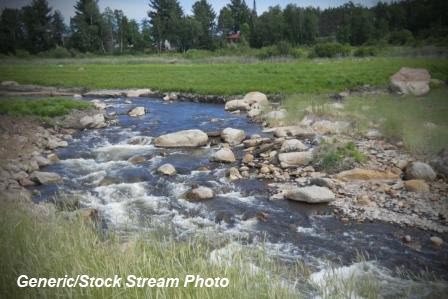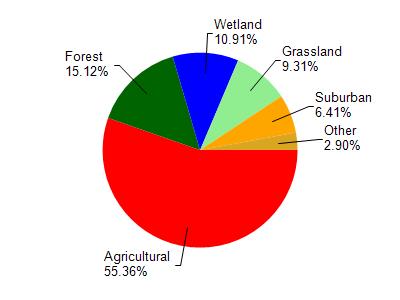
5.16 Miles
0 - 5.16
Macroinvertebrate, Cool-Cold Headwater, Cool-Warm Headwater, Coldwater
2016
Poor
Degraded Habitat, Turbidity
Sediment/Total Suspended Solids
Walworth
No
No
Yes
Fish and Aquatic Life
Overview
Spring Creek flows for a total of 6.3 miles in the Spring Creek subwatershed. It has a contributing drainage area of 8.9 square miles with the entire reach listed as impaired for habitat degradation, turbidity, and sedimentation. The existing use of the entire stream is a Limited Forage Fishery, but a 1995 biological inventory classified it as a Warm Water Sport Fishery. The headwaters of Spring Creek have been historically channelized and are impacted by agricultural land uses. Further downstream, it flows through natural lowland forest before entering another channelized agricultural area. Spring Creek ultimately flows into a well-buffered wetland area downstream before its confluence with Honey Creek. Excessive quantities of soft sediment (greater than 2 feet in some areas) have impaired aquatic habitat.
Water quality in this stream has been degraded because of the agricultural land use, including channelization, wetland drainage via drain tiles, cropland runoff, streambank pasturing, and inadequate runoff filtration buffers. The impacts are sedimentation, and nutrient enrichment. Recommendations in the watershed plan are to reduce suspended solids, establish buffers, and discourage future dredging and wetland drainage activities. The existing use of the entire stream is a Limited Forage Fishery, but a 1995 biological inventory classified it as a Warm Water Sport Fishery. Its potential use is a Warm Water Sport Fishery.
Date 2002
Author Aquatic Biologist
General Condition
Spring Creek flows for a total of 6.3 miles in the Spring Creek subwatershed. It has a contributing drainage area of 8.9 square miles with the entire reach listed as impaired for habitat degradation, turbidity, and sedimentation. The existing use of the entire stream is a Limited Forage Fishery, but a 1995 biological inventory classified it as a Warm Water Sport Fishery. The headwaters of Spring Creek have been historically channelized and are impacted by agricultural land uses. Further downstream, it flows through natural lowland forest before entering another channelized agricultural area. Spring Creek ultimately flows into a well-buffered wetland area downstream before its confluence with Honey Creek.On 2006 303d list, TMDL has been approved 2003.
Date 2013
Author Aquatic Biologist
Condition
Wisconsin has over 84,000 miles of streams, 15,000 lakes and milllions of acres of wetlands. Assessing the condition of this vast amount of water is challenging. The state's water monitoring program uses a media-based, cross-program approach to analyze water condition. An updated monitoring strategy (2015-2020) is now available. Compliance with Clean Water Act fishable, swimmable standards are located in the Executive Summary of Water Condition in 2018. See also the 'monitoring and projects' tab.
Reports
Recommendations
Restore Wetlands
Restore Wetlands
Restore Wetlands
Restore Wetlands
Management Goals
Wisconsin's Water Quality Standards provide qualitative and quantitative goals for waters that are protective of Fishable, Swimmable conditions [Learn more]. Waters that do not meet water quality standards are considered impaired and restoration actions are planned and carried out until the water is once again fishable and swimmable
Management goals can include creation or implementation of a Total Maximum Daily Load analysis, a Nine Key Element Plan, or other restoration work, education and outreach and more. If specific recommendations exist for this water, they will be displayed below online.
Monitoring
Monitoring the condition of a river, stream, or lake includes gathering physical, chemical, biological, and habitat data. Comprehensive studies often gather all these parameters in great detail, while lighter assessment events will involve sampling physical, chemical and biological data such as macroinvertebrates. Aquatic macroinvertebrates and fish communities integrate watershed or catchment condition, providing great insight into overall ecosystem health. Chemical and habitat parameters tell researchers more about human induced problems including contaminated runoff, point source dischargers, or habitat issues that foster or limit the potential of aquatic communities to thrive in a given area. Wisconsin's Water Monitoring Strategy was recenty updated.
Grants and Management Projects
Monitoring Projects
| WBIC | Official Waterbody Name | Station ID | Station Name | Earliest Fieldwork Date | Latest Fieldwork Date | View Station | View Data |
|---|
| 753900 | Spring Creek | 10009264 | Spring Creek 1 Upstream Of Carver School Road | 1/1/2015 | 11/11/2016 | Map | Data |
| 753900 | Spring Creek | 653254 | Spring Creek at Carver Road | 5/22/1979 | 11/2/1995 | Map | Data |
| 753900 | Spring Creek | 10030821 | Spring Creek at Honey Creek Rd | 1/1/2015 | 11/11/2016 | Map | Data |
| 753900 | Spring Creek | 653246 | Spring Creek at Sth 20 | 7/11/1995 | 5/24/2016 | Map | Data |
| 753900 | Spring Creek | 653206 | Spring Creek at Carver School Rd Bi | 11/16/1995 | 10/28/2002 | Map | Data |
|

Watershed Characteristics
Spring Creek is located in the Sugar and Honey Creeks watershed which is 166.22 mi². Land use in the watershed is primarily agricultural (55.30%), forest (15.10%) and a mix of wetland (10.90%) and other uses (18.60%). This watershed has 208.62 stream miles, 1,943.12 lake acres and 9,489.18 wetland acres.
Nonpoint Source Characteristics
This watershed is ranked High for runoff impacts on streams, Medium for runoff impacts on lakes and High for runoff impacts on groundwater and therefore has an overall rank of High. This value can be used in ranking the watershed or individual waterbodies for grant funding under state and county programs.This water is ranked High Stream for individual Rivers based on runoff problems and the likelihood of success from project implementation.
Spring Creek is considered a Macroinvertebrate, Cool-Cold Headwater, Cool-Warm Headwater, Coldwater under the state's Natural Community Determinations.
Natural communities (stream and lake natural communities) represent model results and DNR staff valiation processes that confirm or update predicted conditions based on flow and temperature modeling from historic and current landscape features and related variables. Predicated flow and temperatures for waters are associated predicated fish assemblages (communities). Biologists evaluate the model results against current survey data to determine if the modeled results are corect and whether biological indicators show water quaity degradation. This analysis is a core component of the state's resource management framework. Wisconsin's Riverine Natural Communities.
Cool (Warm-Transition) Headwaters are small, sometimes intermittent streams with cool to warm summer temperatures. Coldwater fishes are uncommon to absent, transitional fishes are abundant to common, and warm water fishes are common to uncommon. Headwater species are abundant to common, mainstem species are common to absent, and river species are absent.
Cool (Cold-Transition) Headwaters are small, usually perennial streams with cold to cool summer temperatures. Coldwater fishes are common to uncommon (<10 per 100 m), transitional fishes are abundant to common, and warm water fishes are uncommon to absent. Headwater species are abundant to common, mainstem species are common to absent, and river species are absent.